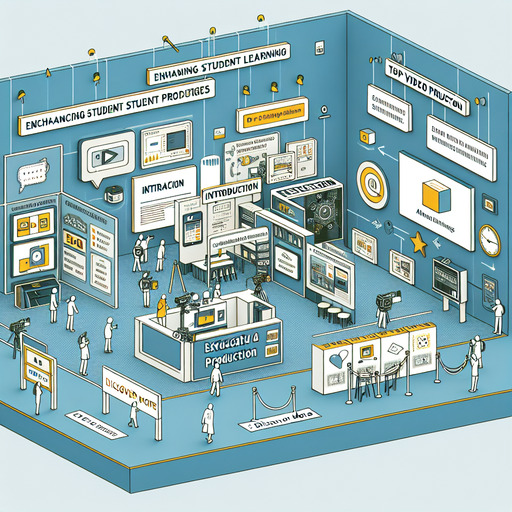
-
Table of Contents
Discover the Top Video Production Strategies for Schools to Enhance Student Learning! Learn More
Introduction
In the rapidly evolving landscape of education, video production has emerged as a powerful tool to enhance student learning and engagement. Schools are increasingly leveraging video content to create dynamic and interactive learning experiences that cater to diverse learning styles. Effective video production strategies can transform traditional teaching methods, making complex concepts more accessible and fostering a more inclusive and stimulating educational environment. This introduction explores the top video production strategies that schools can implement to enrich their educational offerings, improve student comprehension, and promote active participation in the learning process.
Top Video Production Strategies For Schools To Enhance Student Learning
In today’s digital age, video production has emerged as a powerful tool for enhancing student learning in schools. By integrating video content into the curriculum, educators can create more engaging and effective learning experiences. To maximize the benefits of video production, schools should adopt several key strategies that ensure high-quality content and meaningful educational outcomes.
First and foremost, it is essential to identify clear learning objectives before embarking on any video production project. By understanding the specific goals and outcomes desired, educators can tailor their video content to meet these objectives effectively. This approach ensures that the videos are not only engaging but also aligned with the curriculum and educational standards.
Once the objectives are established, the next step is to plan the content meticulously. A well-structured script is crucial for maintaining focus and coherence throughout the video. This script should outline the key points to be covered, the sequence of information, and any visual aids or graphics that will be used. By planning the content in detail, educators can ensure that the video is both informative and engaging.
In addition to a well-crafted script, high-quality visuals and audio are essential components of effective video production. Investing in good equipment, such as high-definition cameras and microphones, can significantly enhance the overall quality of the video. Clear visuals and crisp audio help maintain student engagement and ensure that the content is easily understood. Furthermore, incorporating a variety of visual elements, such as animations, diagrams, and real-life footage, can make complex concepts more accessible and interesting.
Another important strategy is to keep the videos concise and focused. Long videos can lead to cognitive overload and reduced attention spans, especially among younger students. Therefore, it is advisable to break down the content into shorter, manageable segments. Each segment should cover a specific topic or concept, allowing students to absorb the information more effectively. Additionally, shorter videos can be easily integrated into classroom activities and discussions, making them a versatile teaching tool.
To further enhance student learning, it is beneficial to incorporate interactive elements into the videos. Interactive features, such as quizzes, polls, and discussion prompts, can engage students actively and encourage them to think critically about the content. These elements also provide immediate feedback, helping students to assess their understanding and identify areas for improvement. By fostering active participation, interactive videos can transform passive learning into a dynamic and engaging experience.
Moreover, it is important to consider the diverse learning needs of students when producing videos. Different students have different learning styles, and video content should cater to this diversity. For instance, visual learners may benefit from detailed diagrams and animations, while auditory learners may prefer clear explanations and discussions. Providing subtitles and transcripts can also support students with hearing impairments or those who are non-native speakers of the language. By addressing the varied needs of students, educators can create inclusive and effective video content.
Finally, it is crucial to evaluate the effectiveness of the video content regularly. Gathering feedback from students and teachers can provide valuable insights into what works well and what needs improvement. This feedback can be used to refine future video production efforts, ensuring that the content remains relevant and impactful. Additionally, tracking student performance and engagement metrics can help educators assess the overall impact of the videos on learning outcomes.
In conclusion, video production offers a wealth of opportunities for enhancing student learning in schools. By setting clear objectives, planning content meticulously, ensuring high-quality visuals and audio, keeping videos concise, incorporating interactive elements, catering to diverse learning needs, and evaluating effectiveness, educators can create compelling and educational video content. These strategies not only make learning more engaging but also support students in achieving their academic goals.
Q&A
1. **What are some effective video production strategies for schools to enhance student learning?**
– **Flipped Classroom Videos:** Create instructional videos that students can watch at home, allowing class time to be used for interactive activities and deeper learning.
– **Student-Created Content:** Encourage students to produce their own videos on topics they are studying, which can enhance understanding and engagement.
– **Guest Speaker Recordings:** Record guest lectures or expert talks to provide students with access to diverse perspectives and knowledge.
– **Interactive Videos:** Use platforms that allow for quizzes and interactive elements within videos to keep students engaged and assess their understanding in real-time.
– **Tutorials and How-To Videos:** Develop step-by-step guides and tutorials for complex subjects or projects to provide students with additional support outside of class.
– **Live Streaming Events:** Stream school events, such as science fairs or performances, to involve the wider community and provide students with a platform to showcase their work.
– **Virtual Field Trips:** Create or use existing virtual field trip videos to give students experiences they might not otherwise have, enhancing their learning through visual and immersive content.
– **Video Feedback:** Use video to provide personalized feedback on assignments, which can be more detailed and nuanced than written comments.
– **Documentaries and Case Studies:** Produce or use documentary-style videos and case studies to provide in-depth exploration of subjects, making learning more engaging and relatable.
– **Video Announcements and Updates:** Use video for school announcements and updates to make communication more engaging and accessible for students and parents.